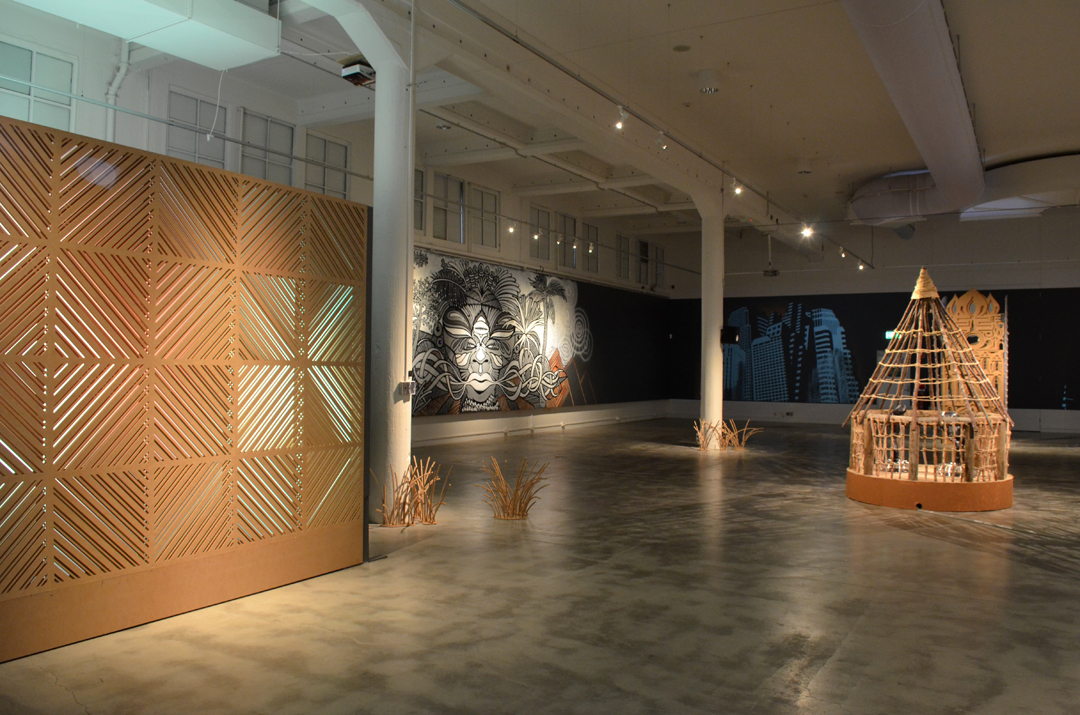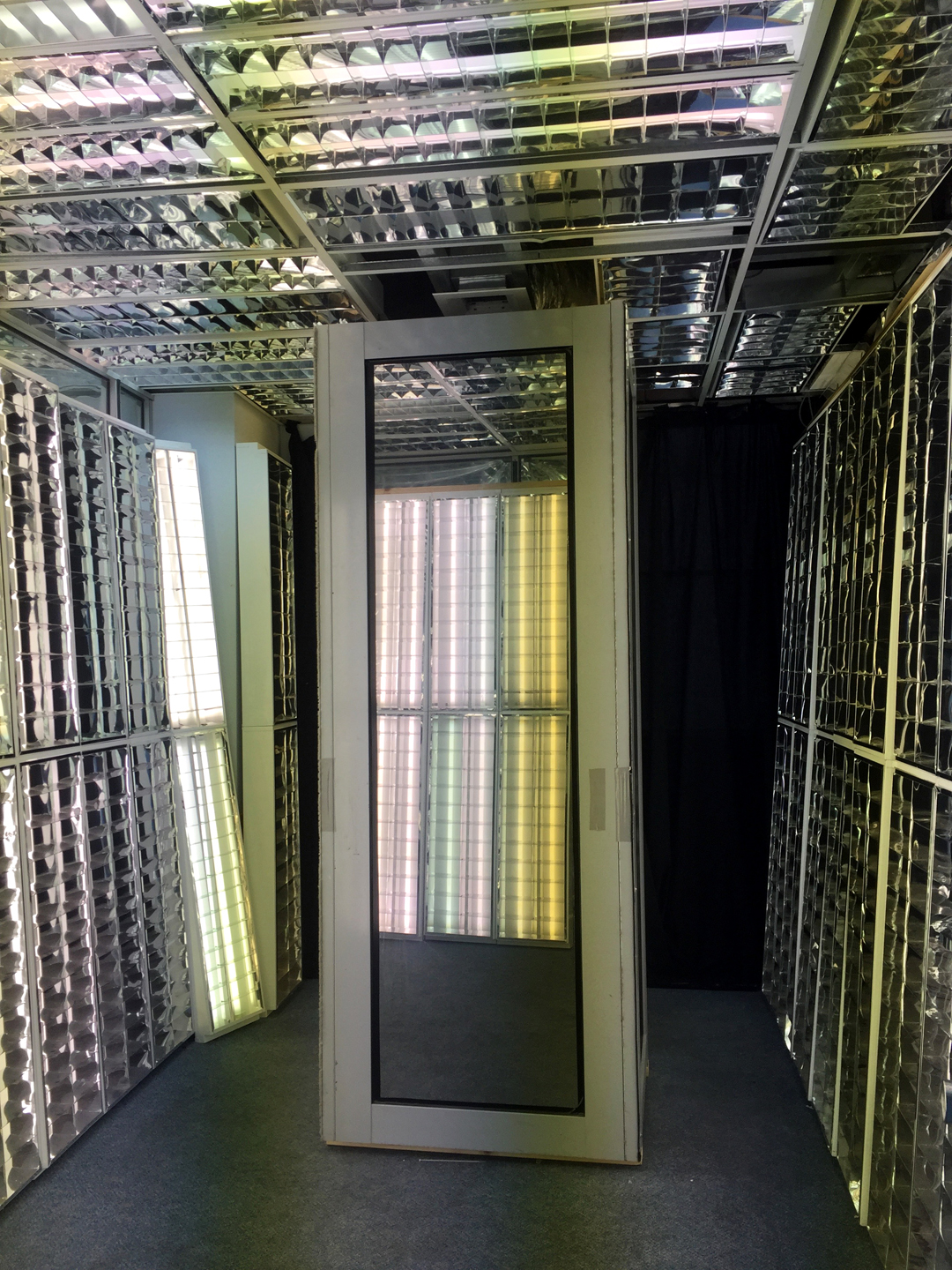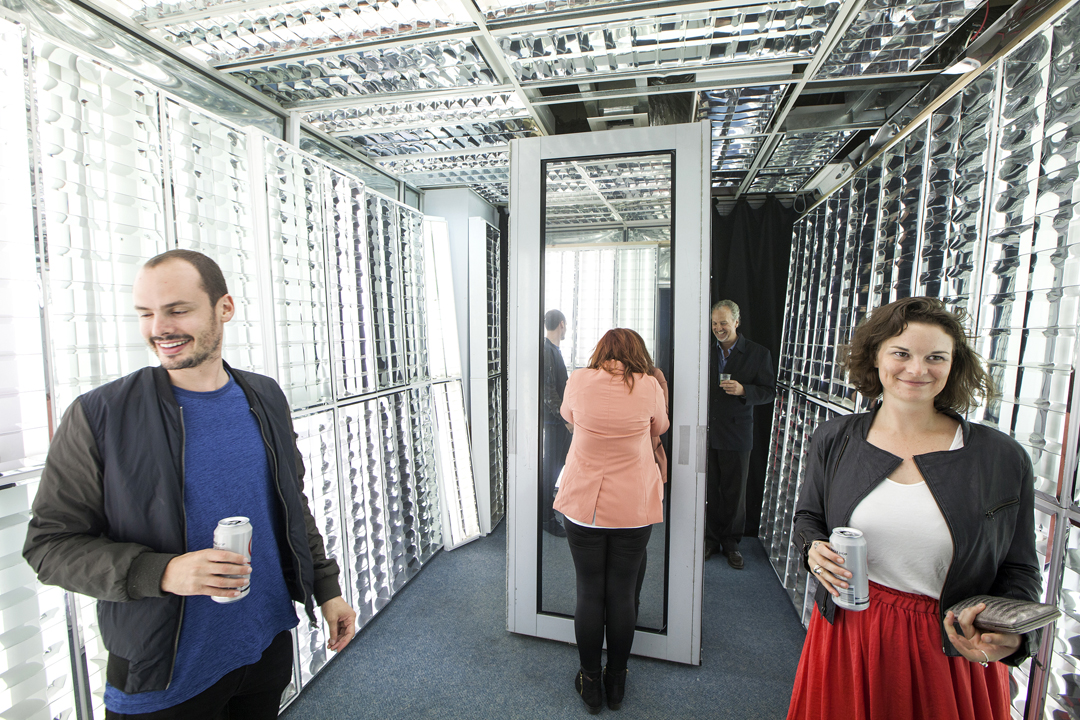Kinetika VII: Umwelt
PLIMSOL GALLERY, CENTRE FOR THE ARTS, HOBART
Phd Examination Submission, University of Tasmania
Kinetika VII: Umwelt is the final work of my PhD thesis at the University of Tasmania. This work proposes a Ganzfeld, or ‘total field’ of lenticular mediation – an opening onto shifting perspectives and the mutability of self within a camouflaging assemblage. The work encourages a proprioceptive engagement from the observer that is not explicitly tacit orinnate – a spatio-temporal encounter that is particular and partial to the work. Kinetika VII has assembled through a process of complex repetitions that have disguised their own variability of elements through dissimilation, displacement, reflection and multiplication; using material and semiotic components that perform a structure of relating and demonstrate emergent properties. A particular and partial configuration of this pattern is revealed to a specific entity at a particular point within the event of the encounter; whilst a multiplicity of variable configurations exist as virtual potentials, at once, within a single physical system. In this way the work draws attention to the intersections of events and reveals a temporal structure of relating.
Link to my PhD Thesis: “Fugitive identity an abstraction of persona through the mask camouflage and material assemblage”
Piecing it Together | 2020
Under the guidance of Tasmanian street artist and muralist, Jamin, our six older and five younger participants designed and created a beautiful piece of art at Eastlands, in the car park between Woolworths and the bus mall. Participants developed skills in different stenciling and spray painting techniques to create the piece with a shared vision about taking risks and stepping into the unknown to embrace change and possibility, much like a bird leaving the nest.
PIECING IT TOGETHER | 2018
The Partnershipping Project | 2018
BURNIE REGIONAL ARTS GALLERY, NOVEMBER 2018
Curated by Pat Hoffie & Rosemary Miller
The Gap Between Worlds.
Assemblage (wood, mirrored mylar, LED lights & components, string, tape, fixings)
Artist Statement:
Within my practice as an artist, I come into contact with, and intersect, a brand range of social and cultural groups and individuals: producers, purveyors and consumers. I am intrigued by the depth of knowledge and specialisation that can occur within one person or grouping that remains occulted, or shrouded in mystery, to another. Like a myriad of worlds that can be glimpsed, but rarely, if ever, entered into. In the German language, the word umwelt (literally environment) has a nuanced meaning that describes how each organism has a particular experience of the world based on its capacity to sense, and make sense. How differently a bee experiences the world to a human! Cascading multiplicities of seperate experiences overlapping each other through space and time.
This work is a meditation on umwelt and specialisation - of how connected we are, and yet ultimately how separate our experiences of life are from one another.
The Partnershipping Project is a project based around an exhibition of art that travels to 4 regional gallery destinations. The works are made by 20 regionally based artists, each of whom has created work in response to the question: ‘does place matter?’
The Partnershipping Project aims to explore the extent to which the places where we live, and the communities with whom we share our lives, and who affect who we are. In the past, place, along with friends, family and traditions, provided the strongest grounds for building a sense of belonging. This exhibition questions the extent to which this might have changed - or not.
Islands: A Speculation | 2017
QUEEN VICTORIA MUSEUM AND ART GALLERY, TEN DAYS ON THE ISLAND
With Nicolas Molle (New Caledonia) and Grace Williams (Tasmania), Curated by Jane Deeth
The connections between the two islands of New Caledonia and Tasmania are curious and remarkable. Colonialisation, Indigenous cultures, significant and fraught mining industries, isolation and French exploration all blend to define the character and complexion of both islands. This project is a collaboration between New Caledonian artist Nicolas Molé, who presented a major installation at the Asia Pacific Triennial in 2016; Grace Williams, an emerging Tasmanian Aboriginal artist; and Jamin.
These three artists share a commitment to collaborative creative processes and use street art aesthetics and animation to bring their thoughts to life. Their speculation will create an immersive experience that illuminates islandness, Indigenous experience and contemporary politics.
ARTISTS: Nicolas Molé, Grace Williams & Jamin
Mona FOMA 2016: Faux MO (THE DEPARTMENT OF NON-HUMAN SERVICES)
Faux Mo 2016 was the second instalment of this festival that I have been involved with. This time around, I curated and directed the visual environment, co-producing the site with Aedan Howlett. In the previous iteration we shared all of the visual roles, a learning experience which led to a more refined and clearly articulated role structure for the 2016 version. Faux Mo began as a small afterparty for the second MONA FOMA festival in 2010, progressing in scale and ambition to become a near rival to the main festival in subsequent years. Faux Mo was originally curated and produced by Supplefox (Hannah Fox & Tom Supple) and Duckpond, until a new team was approached by Brian Ritchie (Curator of MONA FOMA) in 2014. The new team consisted of Aedan Howlett and myself for the visual environment and James Walsh (Dameza) as musical curator. Our first production was in 2015 at the Odeon Theatre, Hobart, and surrounding environs. From the success of this first event, which in many ways was a trial run and a deep learning experience for the team, we were given an expanded degree of agency and control to produce the 2016 version, which included scouting for a suitable venue. Through chance, or happenstance, I discovered that the ex-government building at 12 Murray Street, Hobart, was vacant - and proceeded to make some enquiries which led to the securing of a spectacular site for FM16.
The Observatory | 2016
The Observatory (constructed with assistance from Aedan Howlett & Al Visser for MONA FOMA 2016) is a contemplation and inversion of Chilean artist Ivan Navarro’s Reality Show. In Navarro’s work the viewer witnesses an infinitely extending space presented as an internally mirrored cubicle. However, the viewer is also the object of voyeurism for those outside of the cubicle via the mechanism of one-way mirrors – recalling the mechanisms of surveillance and reality TV shows (such as Big Brother) (Ball 2013, p. 138) whilst evoking the disorienting and endless bureaucratic vision of Franz Kafka, where his protagonists are often caught in social or psychological mazes such as with The Trial (1925). ‘The evolution of Kafka’s work is towards a sober ‘hyper-realism’ that dispenses with impressions and imaginings. Rather than metaphor, Kafka’s hyper-reality constructs an immanent assemblage of metamorphosis, a continuum of reversible intensities’ (Parr, 2010, p.138).
In the case of The Observatory the seemingly invisible viewer within the one-way mirrored cubicle is occulted from those outside of it, who occupy a brightly lit space composed of repurposed fluorescent ceiling lights installed tightly packed across each wall and ceiling. Whilst evocative of surveillance and reality TV shows (where camera crews behind one-way mirrors observe the drama), The Observatory functions like Bentham’s Panopticon in that the participant within the chamber becomes the unseen observer of the room’s occupants, beyond their knowledge (McMullen, 2015). As the work is an event in flux, the role of unknowing subject becomes inverted when an occupant of the room discovers the mostly indiscernible door to the booth, shifting their perception to one that is more like Latour’s ‘oligopticon’, where the totality of the situation is ‘only in a montage of images’ (Pyyhtinen & Tamminen, 2011) caused via the movement, from external, to internal, framed and reframed; each shift causing a new awareness of the event in totality – a swarming – ‘a continuum of reversible intensities’ (Parr, 2010, p.138). This grasping of totalities through a montage of images relates to both Lacan’s idea of the ongoing relations with ‘self’ through the mirror (a montage of encounters throughout one’s life) as well as to the quantum physics implication of a ‘minimum interval of time’ known as ‘Planck time’ (Rovelli, 2018, p 74-75) which suggest a granularity on the smallest scales that also resembles a montage of images.
The reflective surfaces of the work locate the chambers occupants and elements of the surrounding environment within the work itself, creating a sense of belonging (through the reflection of self) or interiority to the work, whilst in actuality remaining distinctly exterior to the observer within the cubicle. In this way the work mimics the spatiality of screen-based technologies and the sense of being within something whilst being distinctly and actually without. In such ways, parallels can be drawn to contemporary social media and the reality bubbles (or Umwelt) that are assembled and given through targeted delivery and extraction of information. The subject, who is mostly unaware of the particular components of the social media assemblage, performs as if their Gestalt perception of social media is the thing itself; closer inspection reveals a far more complex and heterogenous assemblage.
The Observatory draws attention to the spatialising flux of exchange between the occupants of the cubicle and the subjects within the brightly lit chamber. Whilst not all of the subjects within the room become aware of the booth’s occupancy, they are able to switch roles from that of subject to that of observer once the cubicle’s concealed rear door is discovered; and in this fashion, the activities and gestures of the participants become integral to the artwork itself. The Observatory encourages the participants into a relationship with two distinct Umwelt: one composed of exposure, bright lights and mirrored surfaces, the other composed of confined space, muted tones and muffled sound.




















